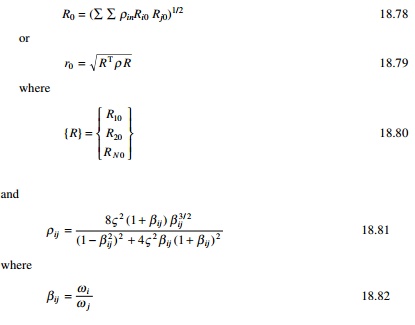Chapter: Civil : Structural dynamics of earthquake engineering
Spectrum analysis by modal response
Spectrum analysis by modal response
In the case of design of
structures, complete time history analysis is not necessary; it is enough to
valuate the peak values of forces and deformations. A good estimate, although
not accurate, of the peak response can be determined directly from response
spectrum for the ground motion. These peak modal responses are combined using
any one of the rules discussed below to get the value of the total response.
This method is known as RSA.
For any response value such as
force or deformation, the peak value Rn0 of the nth
modal contribution is given by

where An(Tn,
Žün) is the
ordinate of the pseudo-acceleration response spectrum corresponding to the
natural vibration period Tn = 2ŽĆ/Žē and the damping ratio Žün. Rn0
is either positive or negative depending on whether Rnst
is positive or negative.
1 Modal contribution rules
Knowing the peak value Rn0
of the nth mode contribution it is necessary to find the peak value R0
if the total response R(t). As we have seen in earlier chapters,
the peak value Rn0 for each node occurs at
different times and the combined peak response may attain its peak at a
different time instance.
2 Absolute sum rule
If we assume that all peak values
of modal responses occur at the same time, and ignore the algebraic sign for
the peak value of the total response, we get

The above estimate is highly
conservative and not popular in structural design applications.
3 SRSS rule
The SRSS rule provides an
estimate of peak value according to the equation

The algebraic sign of Rn0
does not affect the value of R0. This rule is applicable for
structures where natural vibration frequencies are well separated. The SRSS
rule was developed by Rosenblueth (1951).
4 CQC rule
The rule is applicable to wide
range of structures in which natural frequencies of closely spaced such as
those in unsymmetric buildings. According to the CQC rule (first developed by
Rosenblueth and Elorduy)

It is assumed that the damping ratio
Žé is the same for all modes.
Figure 18.27 shows the variation of correlation coefficient with respect to ╬▓ij. It is
to be observed that the correlation coefficient Žüij is
significant at ╬▓ij = 1.
In Žü matrix the leading diagonal
terms are equal to 1. Hence Eq. 18.78 is rewritten as

The first summation of the
right-hand side is identical to SRSS combination rule, whereas the next term
may be positive or negative, depending the algebraic signs of Rn0.
It is also seen from Fig. 18.27 that Žüij Ōēł
0 when Žēi, Žēj move
farther apart. For well-separated vibration frequencies Žüij vanish.
As a result the second term can be neglected and Eq. 18.83 reduces to the SRSS
rule.

5 Factors influencing the earthquake response
There are two parameters which
influence the earthquake response: (1) fundamental natural vibration period T1
and (2) beam to column stiffness ratios based on the properties of the beam and
column in the storey closest to the mid-height of the frame.

where EIb and EIc
are the flexural rigidities of beams and columns and Lb and Lc
denote the lengths of the beams and columns. If ╬│ ŌåÆ Ōł× the beam imposes no restraint on joint rotations and the
frame will bend as a flexure beam. If ╬╗ > Ōł× the
structure will behave like a shear beam with double curvature bending in each
column. An intermediate value of ╬│ represents the column and beam undergoing double curvature
bending. This property ╬│ controls
several properties of the structure when ╬│ is small and the vibration periods are more separated.
As the fundamental period
increases with the velocity and displacement-sensitive regions of the
structure, the higher mode response generally becomes an increasing percentage
of the total response. For design accuracy more modes should be included in the
analysis of buildings with longer periods than the buildings with shorter
period. More modes should be included in the analysis of buildings with smaller
╬│. In some codal provisions, we
have to include the number of modes such that 90% of the total mass is the
participating mass.
Related Topics